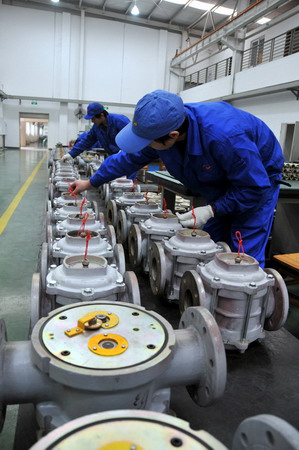Economy
More regional co-op encouraged for industry upgrade
By Zhou Siyu and Lu Hongyan (China Daily)
Updated: 2011-04-07 14:24
 |
Large Medium Small |
|
 |
|
Experts say that the relocation of technologically advanced industries from the coastal regions will help western China reduce the number of businesses that rely heavily on high energy consumption and pollution.[Photo / China Daily] |
It will also help the western region to maintain the upward trend in attracting investments, experts said.
"The western region should strive to upgrade its industrial structure while accommodating the industrial relocation, and the eastern region shall gain more room for further industrial development," said Li Pumin, deputy secretary-general of the NDRC, the country's top economic planner.
Li said that cooperation between the two regions should extend to sectors such as modern services, finance and logistics.
Li's remarks were made at the 15th Investment and Trade Forum for Cooperation between East and West China in Xi'an, capital city of Shaanxi province.
Hao Hongmei, a researcher at the department of foreign investment of the Chinese Academy of International Trade and Economic Cooperation, said that industrial relocation will help the western region reduce the number of businesses that rely heavily on high energy consumption and pollution.
"Western China should also focus on upgrading its industrial structure and avoid simply transferring outdated production lines from the east," she said.
With abundant natural resources including coal and oil, western China takes up 71.5 percent of the country's total area. It covers six provinces, including Gansu, Guizhou, Qinghai and Shaanxi, five autonomous regions and Chongqing municipality.
Compared with the wealthy eastern region, western China is less prosperous. In 2010, the region accounted for 18.7 percent of China's fast-growing GDP, while the eastern region took up 53 percent, according to the National Bureau of Statistics.
In the process of accommodating industrial transfer, the region has also matured in its infrastructure, which reduces the cost of logistics and allows it to "attract more and more investments with a comparatively cheap and qualified work force", Hao added.
Jing Junhai, vice-governor of Shaanxi province, said that the province may still rely on investments to boost its economic development "for a long time".
"Priority will be given to attracting more investments during the next five years," he said.
The province's GDP maintained an increase of 14.9 percent during the last five years, reaching 1 trillion yuan ($153 billion) in 2010. In the same year, FDI to the province surged by 35 percent year-on-year to 850 billion yuan.
"We are facing a great development opportunity. FDI this year is expected to break 1 trillion yuan," Jing said.
During the first two months of this year, FDI to the western region as a whole rose to $1.2 billion, up 104.7 percent from last year, three times higher than the national average increase since January, the Ministry of Commerce said.
From 2005 to 2009, the western region maintained 13.7 percent annual GDP increase on average, the highest compared with other regions in the country, official figures showed.
| 分享按钮 |



